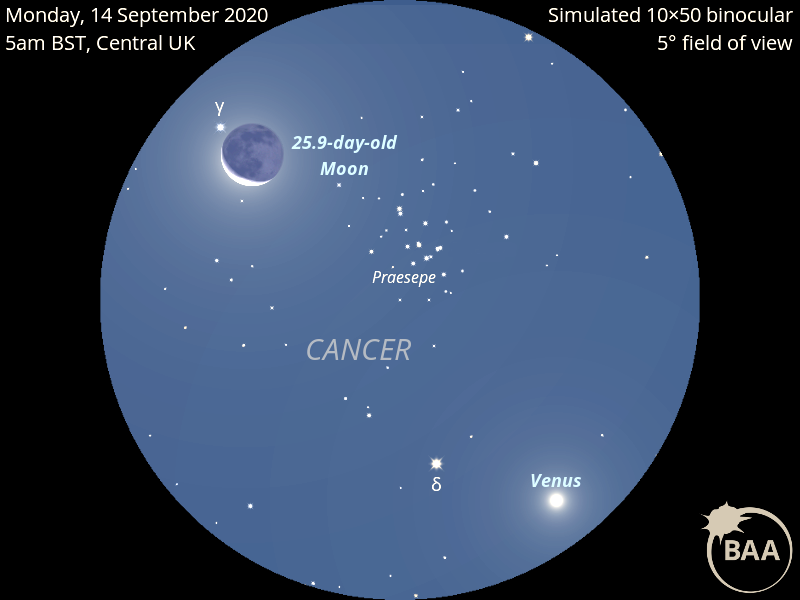
Keen-eyed UK observers will notice that the Moon lies close to the magnitude +4.6 star gamma (γ) Cancri, otherwise known as Asellus Borealis, at this time. Although no occultation of the star occurs as seen from the British Isles, the graze line crosses France, passing through Laval and just north of Paris.
Venus dazzles at magnitude -4.2 on the morning in question with a westerly elongation from the Sun of 43 degrees. Telescopically, the planet has a 65 percent illuminated disc spanning 17½ arcseconds. Magnitude +3.9 star delta (δ) Cancri, otherwise known as Asellus Australis, lies a degree to the upper left of Venus in binoculars and low-power, erect-image telescopes.
https://britastro.org/wp-content/uploads/2022/02/Moon-Praesepe_14Sep2020_5amBST_300x300.png
https://britastro.org/wp-content/uploads/2022/02/Moon-Praesepe_14Sep2020_5amBST_300x300.png
https://britastro.org/wp-content/uploads/2022/02/Moon-Praesepe_14Sep2020_5amBST_300x300.png
https://britastro.org/wp-content/uploads/2022/02/Moon-Praesepe_14Sep2020_5amBST_300x300.png
https://britastro.org/wp-content/uploads/2022/02/Moon-Praesepe_14Sep2020_5amBST_300x300.png
https://britastro.org/wp-content/uploads/2022/02/Moon-Praesepe_14Sep2020_5amBST_300x300.png
https://britastro.org/wp-content/uploads/2022/02/Moon-Praesepe_14Sep2020_5amBST_300x300.png
https://britastro.org/wp-content/uploads/2022/02/Moon-Praesepe_14Sep2020_5amBST_300x300.png
https://britastro.org/wp-content/uploads/2022/02/Moon-Praesepe_14Sep2020_5amBST_300x300.png
https://britastro.org/wp-content/uploads/2022/02/Moon-Praesepe_14Sep2020_5amBST_300x300.png
https://britastro.org/wp-content/uploads/2022/02/Moon-Praesepe_14Sep2020_5amBST_300x300.png
https://britastro.org/wp-content/uploads/2022/02/Moon-Praesepe_14Sep2020_5amBST_300x300.png
https://britastro.org/wp-content/uploads/2022/02/Moon-Praesepe_14Sep2020_5amBST_300x300.png
https://britastro.org/wp-content/uploads/2022/02/Moon-Praesepe_14Sep2020_5amBST_300x300.png
https://britastro.org/wp-content/uploads/2022/02/Moon-Praesepe_14Sep2020_5amBST_300x300.png
https://britastro.org/wp-content/uploads/2022/02/Moon-Praesepe_14Sep2020_5amBST_300x300.png
https://britastro.org/wp-content/uploads/2022/02/Moon-Praesepe_14Sep2020_5amBST_300x300.png
https://britastro.org/wp-content/uploads/2022/02/Moon-Praesepe_14Sep2020_5amBST_300x300.png
https://britastro.org/wp-content/uploads/2022/02/Moon-Praesepe_14Sep2020_5amBST_300x300.png
https://britastro.org/wp-content/uploads/2022/02/Moon-Praesepe_14Sep2020_5amBST_300x300.png
https://britastro.org/wp-content/uploads/2022/02/Moon-Praesepe_14Sep2020_5amBST_300x300.png
https://britastro.org/wp-content/uploads/2022/02/Moon-Praesepe_14Sep2020_5amBST_300x300.png
https://britastro.org/wp-content/uploads/2022/03/Moon-Praesepe_14Sep2020_5amBST_300x300.png
https://britastro.org/wp-content/uploads/2022/03/Moon-Praesepe_14Sep2020_5amBST_300x300.png
https://britastro.org/wp-content/uploads/2022/03/Moon-Praesepe_14Sep2020_5amBST_300x300.png
https://britastro.org/wp-content/uploads/2022/03/Moon-Praesepe_14Sep2020_5amBST_300x300.png
https://britastro.org/wp-content/uploads/2022/02/Moon-Praesepe_14Sep2020_5amBST_300x300.png
https://britastro.org/wp-content/uploads/2022/02/Moon-Praesepe_14Sep2020_5amBST_300x300.png
https://britastro.org/wp-content/uploads/2022/02/Moon-Praesepe_14Sep2020_5amBST_300x300.png
https://britastro.org/wp-content/uploads/2022/02/Moon-Praesepe_14Sep2020_5amBST_300x300.png
https://britastro.org/wp-content/uploads/2022/02/Moon-Praesepe_14Sep2020_5amBST_300x300.png
https://britastro.org/wp-content/uploads/2022/02/Moon-Praesepe_14Sep2020_5amBST_300x300.png
https://britastro.org/wp-content/uploads/2022/02/Moon-Praesepe_14Sep2020_5amBST_300x300.png
https://britastro.org/wp-content/uploads/2022/02/Moon-Praesepe_14Sep2020_5amBST_300x300.png
https://britastro.org/wp-content/uploads/2022/02/Moon-Praesepe_14Sep2020_5amBST_300x300.png
https://britastro.org/wp-content/uploads/2022/02/Moon-Praesepe_14Sep2020_5amBST_300x300.png
https://britastro.org/wp-content/uploads/2022/02/Moon-Praesepe_14Sep2020_5amBST_300x300.png
https://britastro.org/wp-content/uploads/2022/02/Moon-Praesepe_14Sep2020_5amBST_300x300.png
https://britastro.org/wp-content/uploads/2022/02/Moon-Praesepe_14Sep2020_5amBST_300x300.png
https://britastro.org/wp-content/uploads/2022/02/Moon-Praesepe_14Sep2020_5amBST_300x300.png
https://britastro.org/wp-content/uploads/2022/02/Moon-Praesepe_14Sep2020_5amBST_300x300.png
https://britastro.org/wp-content/uploads/2022/02/Moon-Praesepe_14Sep2020_5amBST_300x300.png
https://britastro.org/wp-content/uploads/2022/01/Moon-Praesepe_14Sep2020_5amBST_300x300.png
https://britastro.org/wp-content/uploads/2022/02/Moon-Praesepe_14Sep2020_5amBST_300x300.png
https://britastro.org/wp-content/uploads/2022/02/Moon-Praesepe_14Sep2020_5amBST_300x300.png
https://britastro.org/wp-content/uploads/2022/02/Moon-Praesepe_14Sep2020_5amBST_300x300.png
https://britastro.org/wp-content/uploads/2022/02/Moon-Praesepe_14Sep2020_5amBST_300x300.png
https://britastro.org/wp-content/uploads/2022/01/Moon-Praesepe_14Sep2020_5amBST_300x300.png
https://britastro.org/wp-content/uploads/2022/01/Moon-Praesepe_14Sep2020_5amBST_300x300.png
https://britastro.org/wp-content/uploads/2022/01/Moon-Praesepe_14Sep2020_5amBST_300x300.png
https://britastro.org/wp-content/uploads/2022/01/Moon-Praesepe_14Sep2020_5amBST_300x300.png
https://britastro.org/wp-content/uploads/2022/01/Moon-Praesepe_14Sep2020_5amBST_300x300.png
https://britastro.org/wp-content/uploads/2022/01/Moon-Praesepe_14Sep2020_5amBST_300x300.png
https://britastro.org/wp-content/uploads/2022/02/Moon-Praesepe_14Sep2020_5amBST_300x300.png
https://britastro.org/wp-content/uploads/2022/01/Moon-Praesepe_14Sep2020_5amBST_300x300.png
https://britastro.org/wp-content/uploads/2021/11/Moon-Praesepe_14Sep2020_5amBST_300x300.png
https://britastro.org/wp-content/uploads/2021/11/Moon-Praesepe_14Sep2020_5amBST_300x300.png
https://britastro.org/wp-content/uploads/2021/11/Moon-Praesepe_14Sep2020_5amBST_300x300.png
https://britastro.org/wp-content/uploads/2021/07/Moon-Praesepe_14Sep2020_5amBST_300x300.png
https://britastro.org/wp-content/uploads/2021/07/Moon-Praesepe_14Sep2020_5amBST_300x300.png
https://britastro.org/wp-content/uploads/2020/09/Moon-Praesepe_14Sep2020_5amBST_300x234.png
https://britastro.org/wp-content/uploads/2020/09/Moon-Praesepe_14Sep2020_5amBST_300x300.png
https://britastro.org/wp-content/uploads/2020/09/Moon-Venus-Praesepe_14Sep2020_5amBST_800x600_v2.png
https://britastro.org/wp-content/uploads/2022/02/Moon-Praesepe_14Sep2020_5amBST_300x300.png
https://britastro.org/wp-content/uploads/2022/02/Moon-Praesepe_14Sep2020_5amBST_300x300.png
https://britastro.org/wp-content/uploads/2022/02/Moon-Praesepe_14Sep2020_5amBST_300x300.png
https://britastro.org/wp-content/uploads/2022/02/Moon-Praesepe_14Sep2020_5amBST_300x300.png
https://britastro.org/wp-content/uploads/2022/02/Moon-Praesepe_14Sep2020_5amBST_300x300.png
https://britastro.org/wp-content/uploads/2022/02/Moon-Praesepe_14Sep2020_5amBST_300x300.png
https://britastro.org/wp-content/uploads/2022/02/Moon-Praesepe_14Sep2020_5amBST_300x300.png
https://britastro.org/wp-content/uploads/2022/02/Moon-Praesepe_14Sep2020_5amBST_300x300.png
https://britastro.org/wp-content/uploads/2022/02/Moon-Praesepe_14Sep2020_5amBST_300x300.png
https://britastro.org/wp-content/uploads/2022/02/Moon-Praesepe_14Sep2020_5amBST_300x300.png
https://britastro.org/wp-content/uploads/2020/09/Moon-Venus-Praesepe_14Sep2020_5amBST_800x600_v2.png
https://britastro.org/wp-content/uploads/2022/02/Moon-Praesepe_14Sep2020_5amBST_300x300.png
https://britastro.org/wp-content/uploads/2022/02/Moon-Praesepe_14Sep2020_5amBST_300x300.png
https://britastro.org/wp-content/uploads/2022/02/Moon-Praesepe_14Sep2020_5amBST_300x300.png
https://britastro.org/wp-content/uploads/2022/02/Moon-Praesepe_14Sep2020_5amBST_300x300.png
https://britastro.org/wp-content/uploads/2022/02/Moon-Praesepe_14Sep2020_5amBST_300x300.png
https://britastro.org/wp-content/uploads/2022/02/Moon-Praesepe_14Sep2020_5amBST_300x300.png
https://britastro.org/wp-content/uploads/2022/02/Moon-Praesepe_14Sep2020_5amBST_300x300.png
https://britastro.org/wp-content/uploads/2022/02/Moon-Praesepe_14Sep2020_5amBST_300x300.png
https://britastro.org/wp-content/uploads/2022/02/Moon-Praesepe_14Sep2020_5amBST_300x300.png
| The British Astronomical Association supports amateur astronomers around the UK and the rest of the world. Find out more about the BAA or join us. |
